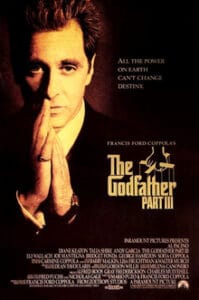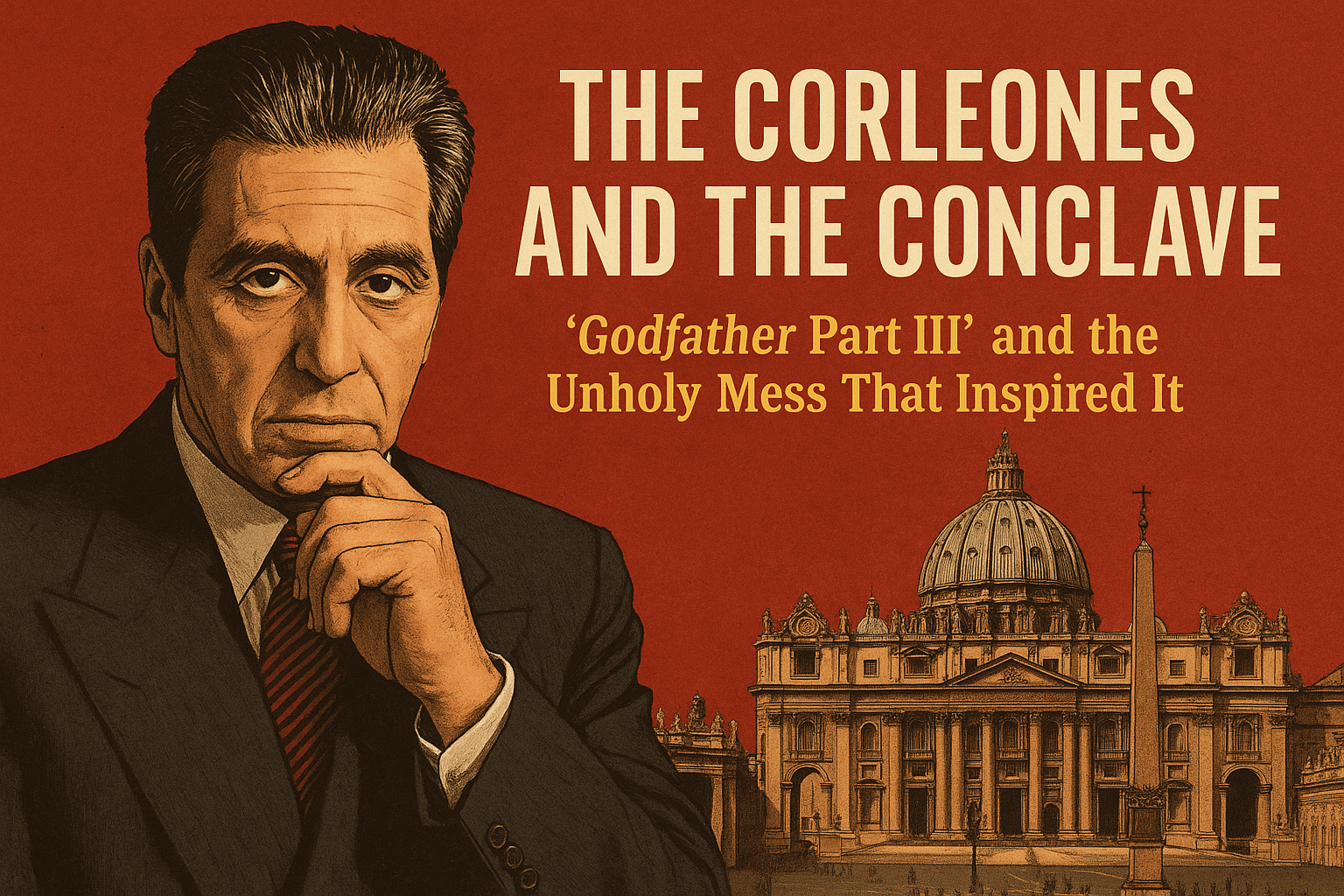The Corleones and the Conclave
Godfather 3 and the Unholy Mess That Inspired It
“Just when I thought I was out… they pull me back in.”
Michael Corleone said it best — but he could’ve just as easily been talking about the Vatican Bank.
When The Godfather Part III hit theaters in 1990, critics focused on its quieter tone, Sofia Coppola’s acting, and how it failed to live up to its predecessors. But what many missed was this: the movie wasn’t merely the swan song of a mafia saga. It was a cinematic confession — a dramatized but disturbingly accurate peek behind the red-draped curtain of Vatican finance.
Because, as it turns out, while Michael Corleone was trying to buy his family’s way into Heaven, the Vatican itself was running a financial sideshow so bizarre, it made the Mafia look… efficient.
Chapter I: God’s Banker and the Financial Gospel of Greed
Our saga begins not in Sicily, but in the sacred, gold-trimmed halls of the Holy See, where money — vast oceans of it — was being handled with all the subtlety of a blackjack dealer at a mob-run casino.
Enter Michele Sindona, a Sicilian financier with a gift for turning money into magic dust. By the early 1970s, Sindona had been welcomed into the Vatican’s economic fold to “modernize” its portfolio. One imagines the cardinals expecting divine dividends. What they got instead was a white-collar conjurer who turned Holy assets into black holes.
Sindona’s tactics? Classic mafia-financier crossover: Swiss accounts, false fronts, shady wire transfers. And, of course, the inevitable collapse of New York’s Franklin National Bank in 1974 — one of the largest bank failures in American history. Guess who got burned in the process? That’s right. The Vatican. Apparently, divine protection doesn’t extend to bad investments.
Chapter II: The Archbishop with a License to Loan
If this sounds bad already, buckle up. Because next, we meet Archbishop Paul Marcinkus — a strapping, cigar-smoking American priest from Chicago who looked more like a bodyguard than a banker. With zero background in finance but lots of experience managing papal itineraries, he somehow landed the job of President of the Institute for the Works of Religion (IOR) — better known as the Vatican Bank.
Putting Marcinkus in charge of billions was like handing your car keys to a bear and hoping for valet service.
Marcinkus quickly joined forces with a rising star in Italian banking, Roberto Calvi, the chairman of Banco Ambrosiano — a bank that would go down in history not for its loans, but for its mysteries. Calvi was dubbed “God’s Banker,” although “God’s Bookie” might’ve been more accurate.
Together, they created a symphony of off-the-books transactions that spanned Panama, Luxembourg, the Bahamas — basically, every sunny place with loose banking laws. Money was moved, disguised, and vanished into corporate shells like disappearing communion wafers.
Chapter III: The Vatican’s Very Own Masonic Thriller
Now, for the part where this story breaks the scandal sound barrier: Calvi, our beloved “God’s Banker,” wasn’t just juggling numbers — he was a card-carrying member of Propaganda Due (P2), a secretive Masonic lodge operating like an Illuminati fan club with actual membership.
P2 had fingers in everything: politics, intelligence, media, the military. It made the Italian deep state look like a kiddie pool. Oh, and did we mention that Calvi’s financial web may have also served the Sicilian Mafia and helped fund anti-Communist operations in places like Nicaragua and Poland?
Let that sink in. The Vatican’s money was possibly used to support Cold War campaigns and the Mafia. “Holy see no evil,” indeed.
Chapter IV: The Banker Who Took a Dive
In 1982, the house of holy cards collapsed. Banco Ambrosiano imploded, leaving behind a €1.3 billion crater and more questions than answers. Calvi, facing criminal charges, did what any embattled banker might do — he fled Italy.
His final destination? London. His final appearance? Less than dignified. He was found hanging from Blackfriars Bridge, his pockets stuffed with bricks and foreign currency. The official ruling? Suicide. The public response? “With bricks in his pants? Please.”
It was murder. Everyone knew it. The only mystery was which of Calvi’s many powerful frenemies had finally decided he was no longer useful.
Chapter V: The Pope Who Died Too Soon
But this story wouldn’t be complete without one last, eerie twist. In 1978, a gentle reform-minded pontiff named Pope John Paul I took the throne. He was humble. Kind. Intent on cleaning house.
He lasted 33 days.
Cause of death? Officially, a heart attack. Unofficially? Let’s just say embalming was suspiciously fast, and no autopsy was conducted. Conspiracy theorists went wild — and not without reason. The timing was perfect for anyone who liked their ledgers messy and their questions unanswered.
Chapter VI: Michael Corleone Goes Legit (Almost)
Enter Coppola, with a script inspired by this perfect storm of holy deceit.
In The Godfather Part III, Michael Corleone, older and haunted, tries to wash his bloodstained hands through a deal with the Church. His goal? Invest $600 million into Internazionale Immobiliare — a Vatican-controlled real estate giant — and buy himself out of sin.
But as he dives into Vatican business, he realizes something chilling: The Church doesn’t just forgive sin… it invests in it.
Archbishop Gilday: Smoking with the Saints
The film gives us Archbishop Gilday, a puffing, puffed-up Marcinkus clone running the Vatican Bank like a back-alley bookie shop. Gilday doesn’t just allow corruption — he embraces it, smoothing over scandals with holy rhetoric and investor doublespeak.
His chain-smoking? A direct nod to Marcinkus’s own habits. His shamelessness? 100% papal-grade.
Frederick Keinszig: Hanging Around
Then there’s Frederick Keinszig, a Swiss banker who ends up dangling beneath a bridge, just like Calvi. No metaphors here — Coppola goes full headline. This was his version of cinematic honesty: Here lies the cost of laundering the sacred.
Cardinal Lamberto: The Good Die Young
Finally, we meet Cardinal Lamberto, the moral center of the film — an echo of Pope John Paul I. He is elected Pope, promises reform, and… is murdered. Sound familiar?
Coppola doesn’t just borrow facts. He elevates them into Shakespearean tragedy. Michael’s last attempt at legitimacy is buried beneath the very institution he hoped would save him.
Chapter VII: What’s Sacred, What’s Corrupt
The Godfather Part III isn’t just a tale of crime — it’s a meditation on the futility of redemption in a world where corruption isn’t limited to street-level gangs. It asks a chilling question: What happens when the mob wants out, but the Church wants in?
Coppola took a mess of real-world conspiracies, scandals, and sins, and turned them into something operatic. Michael Corleone’s journey ends not with redemption, but with the slow realization that some institutions — cloaked in robes, wreathed in incense — are more impenetrable, more untouchable, and far more dangerous than the Mafia ever was.
Epilogue: Beyond the Credits
After the scandal, Marcinkus quietly left the Vatican, never charged with a crime. He retired in Sun City, Arizona, playing golf while the Vatican quietly swept up the mess.
Sindona? Poisoned in prison.
Calvi? Murdered in London.
John Paul I? Still a mystery.
And the Vatican Bank? It’s still around. Still running. Still a little… opaque.
Coppola gave us a film that was less a conclusion and more a confession — whispered through a Hail Mary and filtered through a $600 million check. As Michael Corleone collapses alone in the final scene, you realize:
“sometimes, the path to salvation is blocked not by sin… but by the sacred.”

